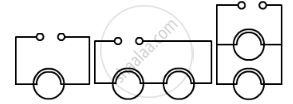Advertisements
Advertisements
Question
Consider the circuit given below:

(a) In which circuit are the lamps dimmest?
(b) In which circuit or circuits are the lamps of equal brightness to the lamps in circuit (i)?
(c) Which circuit gives out the maximum light?
Solution
(a) The lamps will be the dimmest in the series circuit (ii) because the voltage will be divided between the two lamps.
(b) In circuit (iii), the lamps will be as bright as in circuit (i) because circuit (iii) is a parallel arrangement. In a parallel arrangement, the voltage remains the same.
(c) Circuit (iii) will give the maximum light as circuit (iii) has a parallel arrangement. A parallel arrangement offers less resistance and thus circuit (iii) will give more light.
APPEARS IN
RELATED QUESTIONS
Three 2 V cells are connected in series and used as a battery in a circuit.
How many joules of electrical energy does 1 C gain on passing through (i) one cell (ii) all three cells?
How many milliamperes as there in 1 ampere?
State two differences between the e.m.f and terminal voltage of a cell.
An electric oven is rated as 1.5 kW, 250 V. If it is connected to a 250 V mains, calculate the
(a) Current drawn,
(b) Energy consumed in 20 hours,
(c) Cost of energy consumed in 20 hours at the rate of Re. 1 per unit.
What is the function of a step-up transformer?
Two electric bulbs rated 100 W; 220 V and 60 W; 220 V are connected in parallel to electric mains of 220 V. Find the current drawn by the bulbs from the mains.
In current electricity, a positive charge refers to ______.
Match the items in column-I to the items in column-II:
| Column - I | Column - II | ||
| (i) | electric current | (a) | volt |
| (ii) | potential difference | (b) | ohm meter |
| (iii) | specific resistance | (c) | watt |
| (iv) | electrical power | (d) | joule |
| (v) | electrical energy | (e) | ampere |
